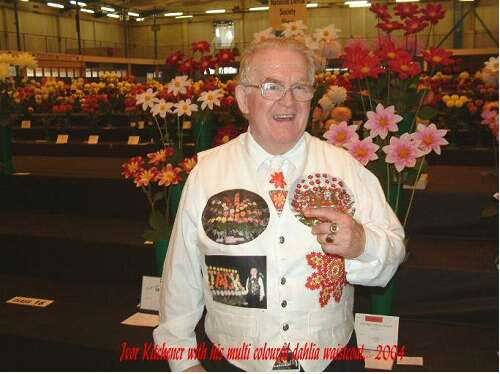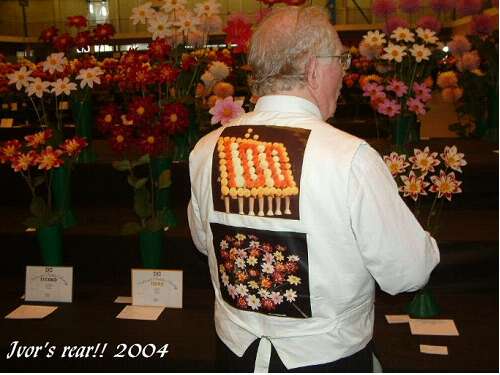 THE GROWING WORLD OF DAHLIAS
THE GROWING WORLD OF DAHLIAS
![]()
|
Section (a)
1). Colour range. The analysis of the colour range recorded on pages 47-51 inc.
confirms that the percentage of seedlings having the same colours as the seed
parent ranged approximately from 50 to 70% for the seven varieties in the study.
The seed parent that produced the greatest range of colours was Sue Mountjoy. Is
this one reason why so many of its seedlings have obtained firsts in NDS shows
in the last two years?
2). Dates of flowering. The rate of first flowers opening against time was
constant for at least 70% of the seedlings. Thus the supposition that a peak in
the appearance of first flowers is negated. However, the steady rate as seen in
the graph on page 25 shows that the maximum difference when 10% of the flowers
had opened (10 days) rose linearly to 20 days when 80% had opened.
3). Collar length. The percentage of seedlings meeting the criterion that the
collar petals of collerettes must be a minimum of one third the length of the
main petals was over 80% in this study. This is deemed to be because there were
no other classifications in the area.
4). Selected seedlings. The percentage of seedlings deemed, at the first flower
stage, to have sufficient exhibition potential to be given a trial in 2005 was
10%. However, by the time the tubers had been put into storage this had fallen
to approximately 7%.
5). Eccentricities. Two flowers had red discs. Ten of the 619 flowers were fully
double. One of these was of waterlily/collerette form another of small
decorative/collerette form. Fifty seven first flowers had no collar petals.
6). Extra petals. 27% had extra petals. A lot of these first flowers had just
one extra petal. This may well not occur in subsequent flowers. However, my
experience indicates that when several extra petals occur that this undesirable
characteristic persists.
7). Seeds planted to reach first flower stage. The percentage of seeds to result
in plants to reach flowering stage varied from approximately 50% to 70% for the
six seed parents that had this data recorded. The reasons for losses were poor
germination, inferior seedlings and damage while being potted on, but figures
for these parameters were not recorded. So the figures calculated merely serve
as a guide to indicate how many seeds should be sown to provide the desired
number to reach the flowering stage.
Section (b)
Source of pollination The effect of pollination, as conducted in this study,
suggests that the effect is minimal as the characteristics imparted by the seed
parent are so dominant. The similarities and differences noted for the covered
(C) and uncovered plants(U) were:-
1. Percentage of seeds to reach first flowering stage was (U) 68%, (C) 71%. Very
similar.
2. Percentage of seedlings planted out to reach first flower stage was (U) 82%,
(C) 86%. Very similar.
3. Percentage having required collar petal length was (U) 85%, (C) 80%. No
significant difference.
4. Percentage having no collar (U) 10%, (C) 10%. Same
5. Percentage having extra petals was (U) 39%, (C) 38%. Same.
6. Number of fully double flowers was (U) 4, (out of 10 in the study) and (C) 0.
Quite a difference.
7. Percentage selected for trial in 2005 was (U) 9.2%, (C) 14.6%. Significant
difference.
8. The range of colours of first flowers from (U) and (C) was quite different
although the overall percentages of colours was quite close as seen in the
relevant graphs on page 48. The main conclusions are firstly that this study
indicates that a definitive comparison of the effect of pollination requires
that plants should be considerable distances apart to ensure different
pollinating insects and secondly that far more than 100 plants should be grown
for the results to be statistically significant.
Section (c)
The objective was that about 100 plants of each seed parent should be grown.
This was achieved for only one half of the seed parents. The information yielded
shows meaningful differences, but indicates that the number should ideally be
far greater as suggested above. If the average ratio of seeds to exhibition
winners is of the order quoted by many hybridists � 1 in 300 approximately �
then the number of plants grown should be an order of magnitude greater, perhaps
3000, to really qualify the results to be statistically significant! In practice
my limited space and energy determined the figure of 100 for this study.
In this context I would quote the findings of hybridists I spoke to at the Ebbw
Vale Garden Festival who endeavoured to improve or create other variations of
The Bishop of Llandaff. They grew 5000 seedlings but produced none to match the
seed parent.
Finally, to emphasise the contention that some seed parents produce far more
exhibition winners than other varieties, I will quote the record of Sue Mountjoy
seedlings. This variety was grown as a seedling in 2000 and was named after
being in the winning set of vases in the Collerette Championship at the NDS Show
at Shepton Mallet in 2002. In 2003 SM seedlings, Demi Schneider, Edith Jones and
Jacquie Hurst won the Collerette Championship, Louisa Douthwaite won the
individual vase and Della Stovell won the Seedling Class. In 2004 two of the
three vases in the Collerette Championship had Sue Mountjoy as the seed parent �
unnamed seedling 38 and Demi Schneider. The other vase was named as �Jenny
Smith�. This came from �mixed seed� that I used in pursuance of the standard
procedure in scientific tests to have a �control batch�.
The extraordinary yield from Sue Mountjoy is put into context by the fact that I
grew only 60 � 70 seedlings a year from this seed parent.
The practical aspect of using these methods to enhance the chances of producing
top exhibition varieties is that the process of finding the SUPER seed parent is
completely unscientific and the inevitable alternative of using �hit or miss�
efforts is seldom productive. Which point emphasises the clich� that research is
99% perspiration and 1% inspiration. I certainly experienced the former.

